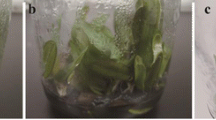Abstract
Changing environmental conditions greatly affect the accumulation of many proteins; therefore, the analysis of alterations in the proteome is essential to understand the plant response to abiotic stress. Proteomics provides a platform for the identification and quantification of plant proteins responsive to cold stress and taking part in cold acclimation. Here, we describe the preparation of proteins for LC-MS measurement to monitor the changes of protein patterns during cold treatment in Arabidopsis thaliana. In our protocol, proteins are precipitated using TCA/acetone, quantified with 2D Quant Kit and digested with trypsin using a filter-based method and analyzed using an LC-MS approach. The acquired results can be further applied for label-free protein quantification.
Access this chapter
Tax calculation will be finalised at checkout
Purchases are for personal use only
Similar content being viewed by others
References
Heidarvand L, Amiri RM (2010) What happens in plant molecular responses to cold stress? Acta Physiol Plant 32:419–431
Yan SP, Zhang QY, Tang ZC et al (2006) Comparative proteomic analysis provides new insights into chilling stress responses in rice. Mol Cell Proteomics 5:484–496
Fanucchi F, Alpi E, Olivieri S et al (2012) Acclimation increases freezing stress response of Arabidopsis thaliana at proteome level. Biochim Biophys Acta 1824:813–825
Amme S, Matros A, Schlesier B et al (2006) Proteome analysis of cold stress response in Arabidopsis thaliana using DIGE-technology. J Exp Bot 57:1537–1546
Lee DG, Ahsan N, Lee SH et al (2009) Chilling stress-induced proteomic changes in rice roots. J Plant Physiol 166:1–11
Gharechahi J, Alizadeh H, Naghavi MR et al (2014) A proteomic analysis to identify cold acclimation associated proteins in wild wheat (Triticum urartu L.). Mol Biol Rep 41:3897–3905
Golebiowska-Pikania G, Kopec P, Surowka E et al (2017) Changes in protein abundance and activity involved in freezing tolerance acquisition in winter barley (Hordeum vulgare L.). J Proteomics 169:58–72
Zhu WH, Smith JW, Huang CM (2010) Mass spectrometry-based label-free quantitative proteomics. J Biomed Biotechnol 2010:840518
Hu RS, Zhu XX, Xiang SP et al (2018) Comparative proteomic analysis reveals differential protein and energy metabolisms from two tobacco cultivars in response to cold stress. Acta Physiol Plant 40:19
Lee J, Lee Y, Kim M et al (2017) Quantitative shotgun proteomic analysis of cold-stressed mature rice anthers. Plant Biotechnol Rep 11:417–427
Ma J, Wang DH, She J et al (2016) Endoplasmic reticulum-associated N-glycan degradation of cold-upregulated glycoproteins in response to chilling stress in Arabidopsis. New Phytol 212:282–296
Schlesier B, Mock HP (2006) Protein isolation and second-dimension electrophoretic separation. Methods Mol Biol 323:381–391
Distler U, Kuharev J, Navarro P et al (2014) Drift time-specific collision energies enable deep-coverage data-independent acquisition proteomics. Nat Methods 11:167–170
Tyanova S, Temu T, Cox J (2016) The MaxQuant computational platform for mass spectrometry-based shotgun proteomics. Nat Protoc 11:2301–2319
Author information
Authors and Affiliations
Corresponding author
Editor information
Editors and Affiliations
Rights and permissions
Copyright information
© 2020 Springer Science+Business Media, LLC, part of Springer Nature
About this protocol
Cite this protocol
Jozefowicz, A.M., Döll, S., Mock, HP. (2020). Proteomic Approaches to Identify Proteins Responsive to Cold Stress. In: Hincha, D., Zuther, E. (eds) Plant Cold Acclimation. Methods in Molecular Biology, vol 2156. Humana, New York, NY. https://doi.org/10.1007/978-1-0716-0660-5_12
Download citation
DOI: https://doi.org/10.1007/978-1-0716-0660-5_12
Published:
Publisher Name: Humana, New York, NY
Print ISBN: 978-1-0716-0659-9
Online ISBN: 978-1-0716-0660-5
eBook Packages: Springer Protocols




